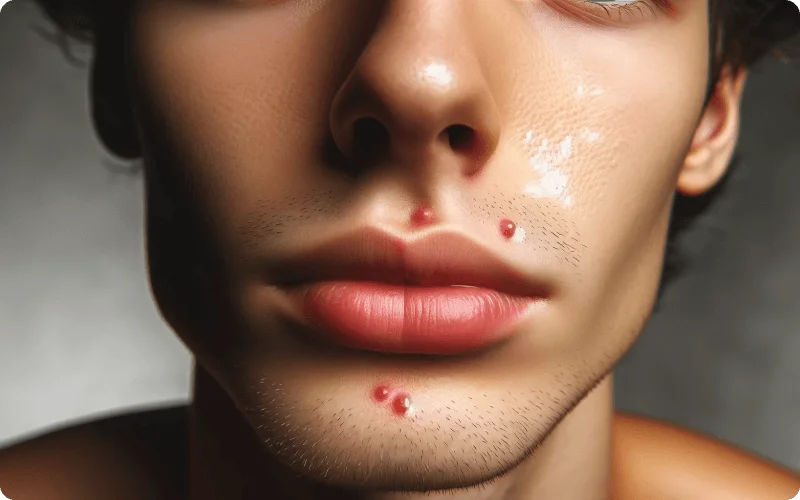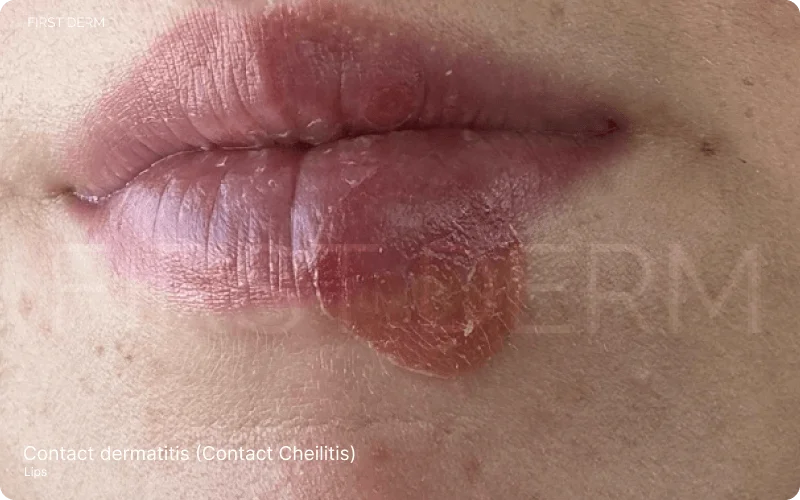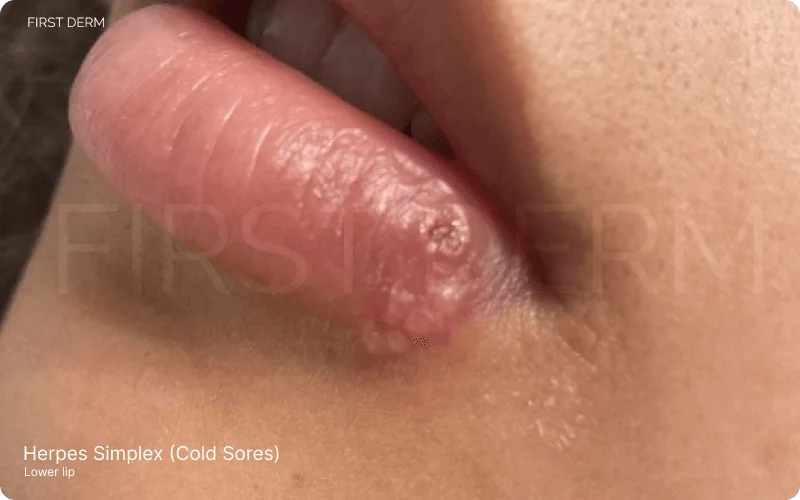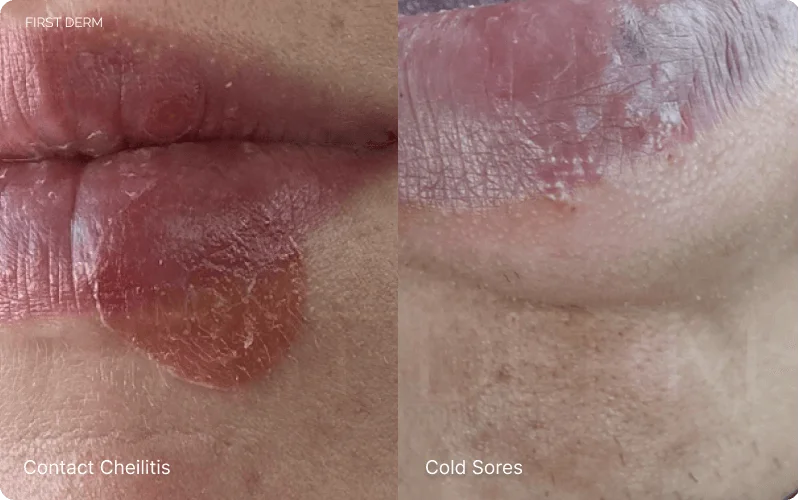Contact Dermatitis vs Cold Sores: Identifying the Difference

Key Takeaways
-
Distinct Symptoms: Contact Dermatitis manifests as red, scaly patches, while Cold Sores appear as clusters of painful blisters.
-
Causes:
- Contact Dermatitis: Allergic reactions to irritants.
- Cold Sores: Viral infections, with a tendency for recurrence.
-
Treatment: Specific treatments vary; Contact Dermatitis often requires topical applications, whereas Cold Sores are treated with antiviral medications.
-
Prevention: Awareness of triggers and lifestyle adjustments can help prevent outbreaks of both conditions.
-
Seek Professional Advice: Accurate diagnosis and treatment are crucial for effective management of these conditions.
Everyone when they see any unusual lesions on their face, they become extremely concerned about many things like the cosmetic outcome of this lesion, whether it will leave a permanent trace, the cause of it, and how to effectively get rid of it fast. Especially if this lesion is on the lip.
Contact dermatitis (Allergic contact cheilitis) and herpes simplex labialis (cold sores, orolabial herpes) are the two most common lip lesions today. However, they are very similar in appearance with a few differences. Failure to point out those differences leads to delayed management and treatment so, it is very important to differentiate between them to diagnose the lesion correctly and treat it successfully with the best outcome. This guide aims to clarify these differences to aid in better health decisions.
Overview: Contact dermatitis on the lips and Herpes Simplex Labialis (Cold Sores)
Contact dermatitis on the lips: Contact Cheilitis

Close-up view of contact dermatitis cheilitis on the lower lip, featuring tiny blisters and a reddish patch
Contact dermatitis is a type of eczema triggered by contact with a particular substance causing an irritation or an allergic reaction. It appears as a red, swelled area with an itching or burning sensation of the outer lip or lip margin. In severe reactions, there also might be vesicles, bullae, and crusts.
Contact dermatitis is a very common condition actually it is the second most common complaint in dermatology patients according to The National Health and Nutrition Examination Survey (NHANES). They also estimated the prevalence of contact dermatitis to be 13.6 cases per 1000 population.[1]
The prevalence of this condition is high in all ages as many products used daily now have possible allergens or irritants such as lip cosmetics, dental hygiene products, medications, and even food.[2]
Herpes Simplex Labialis (Cold Sores)

Herpes Simplex Labialis (Cold Sores) with a primary blister on the lip, surrounded by a cluster of smaller blisters, showing signs of scabbing and swelling.
Cold Sores is a viral infection caused by herpes simplex virus type 2 (HSV-2). It causes a mild, self-limiting painful blistering around the mouth. It is very common that about 20% to 40% of adults get affected at some point in their lives.
Primary infection usually occurs in childhood. Recurrence might occur after exposure to bright light, stress, and fatigue. Before the vesicles appear a tingling, itching, or burning sensation might be felt. Over a few days, the vesicles form a crust, and the eruption resolves within 7-10 days.[3]
Contact Cheilitis vs. Cold Sores: Visual Differences and Causes

Visual comparison: Contact Cheilitis on the left, depicted with red and scaly lip patches, against Cold Sores on the right, illustrated by clustered vesicles on an inflamed base.
Contact Cheilitis
- Appearance Timing: Develops within minutes to 48 hours after exposure to an irritant or allergen.
- Location: Limited to the area of contact with the irritant or allergen.
- Shape and Distribution: Takes the shape of the substance causing the reaction.
- Symptoms Development:
- Initial redness.
- Formation of vesicles.
- Erosion leading to crust formation.
- Accompanied by itching or a burning sensation.
- The affected area may be scaly and dry.
- Common Causes:
- Lip cosmetics (in women) and toothpastes (in men).
- Medications, particularly in the elderly.
- Dental materials and oral hygiene products.
- Food allergies.
- Sunscreens.
- Metals in dental restorations and other items.[2]
Cold Sores (Herpes Simplex Labialis)
- Appearance Timing: Develop within 2 to 6 weeks of infection.
- Symptoms Development:
- Painful, grouped vesicles on a red, inflamed base.
- Vesicles may fill with pus.
- Formation of a crust towards the end of the infection.
- Preceded by a burning or tingling sensation.
- Possible flu-like symptoms (fever, fatigue).
- Infection and Recurrence:
- Contracted through close contact with infected secretions.
- Recurrent infections triggered by stress, infection, or injury.
- The virus remains dormant in the body.
Distinguishing Factors
- Early Stages:
- Cold sores: Begin as blisters, often with a burning sensation.
- Contact dermatitis: Appears as red or scaly patches, typically itchy.[4]
- Key to Diagnosis: These variations in initial symptoms can help determine the condition.
Treatment strategies
For accurate diagnosis and treatment of skin conditions, it’s crucial to consult a dermatologist. A professional opinion based on your symptoms is essential. Considering an initial consultation with a dermatology expert can be the ideal approach to ensure you’re receiving the right guidance and care for your specific skin concerns.
Steps to treat contact dermatitis
- The most important step is identifying the irritant or allergen and avoiding it to treat the current lesion and prevent future lesions. If you are unsure of the cause you should ask your doctor for a patch test to identify any possible allergens and avoid them.
- If you come in contact with an irritant wash with water or a weak neutralizing solution.[5]
Medications
- Topical corticosteroids are applied to the affected area to reduce inflammation and itching.
- Antihistamines to reduce swelling and relieve itching.
- Topical emollients like Petroleum jelly or lip balms that contain no irritants or allergens to prevent dryness and cracking
The condition resolves within 2-4 weeks but only if you avoid the irritant and any other possible irritants.
If the condition persists or the general status becomes worse it is very important to contact a doctor or dermatologist.
Treatment for cold sores
Cold sores usually heal on their own within 7-10 days. Some people use topical treatments to relieve the uncomfortable symptoms of cold sores.
For those Over-the-counter and prescription treatments are available, including:
- Topical creams containing local anesthetics for the pain.
- Cold sore patches, protect the affected area while the cold sore heals. This can protect it from irritation and reduce the likelihood of the virus spreading to others.
- Antiviral creams or tablets (oral valacyclovir 2 grams twice daily for one day). They may help to speed up healing by about a day if used within 24 hours of the first sign of a cold sore.
It is very important to highlight that the use of antivirals is only useful before the appearance of the sore when the tingling sensation occurs.[6]
Prevention
Contact dermatitis:
- It is very important to identify any possible allergens and to do a patch test to identify them.
- Not to use any new products before testing those on a small part of the skin to make sure that it won’t cause any reaction.
Cold sores:
Avoiding physical contact with someone who has a cold. People can still spread HSV-1 when there are no cold sores, but it is less likely.
If someone has an active HSV-1 infection, avoid the following:
- Sex through the mouth.
- Sharing utensils, cups, lip balms, and other personal care products
- Touching the skin near their mouth.
And of course taking care of personal hygiene.
Conclusion
We have discussed everything you need to know to identify the difference between contact dermatitis and cold sores and how to correctly treat them. Diagnosing any lesion that appears on your body is crucial to prevent any possible complications that could have been avoided by having the needed knowledge.
In the end, the important thing is that you be proactive never ignore any condition you have, and know that you should always ask for help when you need it.
We try to provide you with any knowledge to assure and help you but professional interference is always the right answer so when in doubt consult a doctor and never feel that your concern isn’t valid.
References
- Salo PM, Arbes SJ, Jaramillo R, et al. Prevalence of allergic sensitization in the U.S.: Results from the National Health and Nutrition Examination Survey (NHANES) 2005–2006. The Journal of allergy and clinical immunology. 2014;134(2):350-359. doi:https://doi.org/10.1016/j.jaci.2013.12.1071
- Schena D, Fantuzzi F, Girolomoni G. Contact allergy in chronic eczematous lip dermatitis. European Journal of dermatology: EJD. 2008;18(6):688-692. doi:https://doi.org/10.1684/ejd.2008.0520
- Worrall G. Herpes Labialis. BMJ Clinical Evidence. 2009;2009:1704. https://www.ncbi.nlm.nih.gov/pmc/articles/PMC2907798/
- Bhutta BS, Hafsi W. Cheilitis. PubMed. Published 2020. https://www.ncbi.nlm.nih.gov/books/NBK470592/
- So JK, Hamstra A, Calame A, Hamann CR, Jacob SE. Another Great Imitator: Allergic Contact Dermatitis Differential Diagnosis, Clues to Diagnosis, Histopathology, and Treatment. Current Treatment Options in Allergy. 2015;2(4):333-348. doi:https://doi.org/10.1007/s40521-015-0064-y
- Saleh, D., Yarrarapu, S.N.S., & Sharma, S. (2023, August 28). Herpes Simplex Type 1. In StatPearls [Internet]. Treasure Island (FL): StatPearls Publishing; 2023 Jan-. Retrieved from https://www.ncbi.nlm.nih.gov/books/NBK482197/
- Habif, T. P., & Dinulos, J. G. H. (2019). Clinical Dermatology: A Color Guide to Diagnosis and Therapy (7th ed.). Edinburgh: Elsevier.
- James WD Elston DM Berger TG Andrews GC. Andrews’ Diseases of the Skin : Clinical Dermatology. 11th ed. London: Saunders Elsevier; 2011. Accessed January 10 2024.
Ask a Dermatologist
Anonymous, fast and secure!

Dr. Raquel Molina Martinez is a board-certified dermatologist from Barcelona with over a decade of experience. Trained at Gothenburg’s University Hospital, she now practices at Centre Medic in Catalonia.

